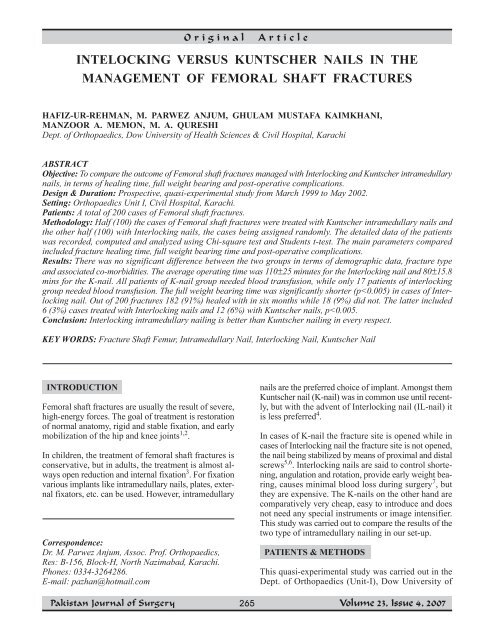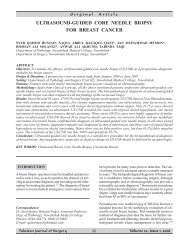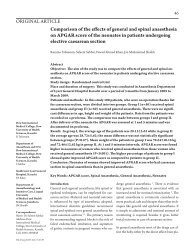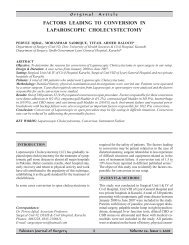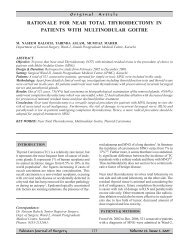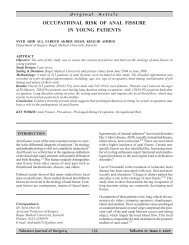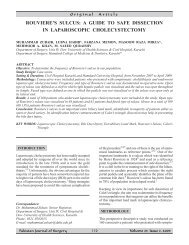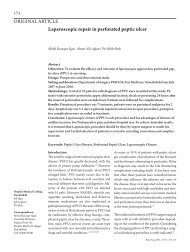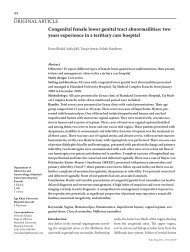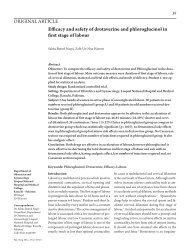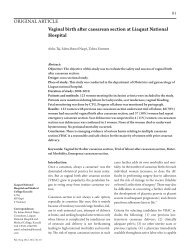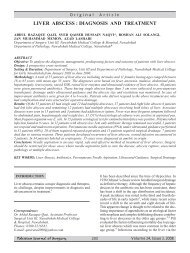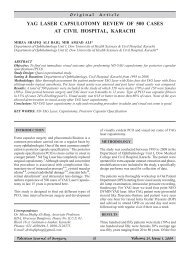Interlocking versus Kuntscher Nails in the management of Femoral ...
Interlocking versus Kuntscher Nails in the management of Femoral ...
Interlocking versus Kuntscher Nails in the management of Femoral ...
Create successful ePaper yourself
Turn your PDF publications into a flip-book with our unique Google optimized e-Paper software.
Orig<strong>in</strong>al<br />
Article<br />
INTELOCKING VERSUS KUNTSCHER NAILS IN THE<br />
MANAGEMENT OF FEMORAL SHAFT FRACTURES<br />
HAFIZ-UR-REHMAN, M. PARWEZ ANJUM, GHULAM MUSTAFA KAIMKHANI,<br />
MANZOOR A. MEMON, M. A. QURESHI<br />
Dept. <strong>of</strong> Orthopaedics, Dow University <strong>of</strong> Health Sciences & Civil Hospital, Karachi<br />
ABSTRACT<br />
Objective: To compare <strong>the</strong> outcome <strong>of</strong> <strong>Femoral</strong> shaft fractures managed with <strong>Interlock<strong>in</strong>g</strong> and <strong>Kuntscher</strong> <strong>in</strong>tramedullary<br />
nails, <strong>in</strong> terms <strong>of</strong> heal<strong>in</strong>g time, full weight bear<strong>in</strong>g and post-operative complications.<br />
Design & Duration: Prospective, quasi-experimental study from March 1999 to May 2002.<br />
Sett<strong>in</strong>g: Orthopaedics Unit I, Civil Hospital, Karachi.<br />
Patients: A total <strong>of</strong> 200 cases <strong>of</strong> <strong>Femoral</strong> shaft fractures.<br />
Methodology: Half (100) <strong>the</strong> cases <strong>of</strong> <strong>Femoral</strong> shaft fractures were treated with <strong>Kuntscher</strong> <strong>in</strong>tramedullary nails and<br />
<strong>the</strong> o<strong>the</strong>r half (100) with <strong>Interlock<strong>in</strong>g</strong> nails, <strong>the</strong> cases be<strong>in</strong>g assigned randomly. The detailed data <strong>of</strong> <strong>the</strong> patients<br />
was recorded, computed and analyzed us<strong>in</strong>g Chi-square test and Students t-test. The ma<strong>in</strong> parameters compared<br />
<strong>in</strong>cluded fracture heal<strong>in</strong>g time, full weight bear<strong>in</strong>g time and post-operative complications.<br />
Results: There was no significant difference between <strong>the</strong> two groups <strong>in</strong> terms <strong>of</strong> demographic data, fracture type<br />
and associated co-morbidities. The average operat<strong>in</strong>g time was 110±25 m<strong>in</strong>utes for <strong>the</strong> <strong>Interlock<strong>in</strong>g</strong> nail and 80±15.8<br />
m<strong>in</strong>s for <strong>the</strong> K-nail. All patients <strong>of</strong> K-nail group needed blood transfusion, while only 17 patients <strong>of</strong> <strong>in</strong>terlock<strong>in</strong>g<br />
group needed blood transfusion. The full weight bear<strong>in</strong>g time was significantly shorter (p
Intramedullary <strong>Nails</strong> <strong>in</strong> <strong>the</strong> Management <strong>of</strong> <strong>Femoral</strong> Shaft Fractures<br />
H. Rehman, et al<br />
Health Sciences and Civil Hospital, Karachi from March<br />
1999 to March 2002. In this comparative study 200<br />
patients <strong>of</strong> femoral shaft fractures were managed by<br />
<strong>in</strong>tramedullary nail<strong>in</strong>g, half (100) with <strong>Kuntscher</strong> nail<br />
and half (100) with <strong>Interlock<strong>in</strong>g</strong> nail.<br />
Amongst <strong>the</strong> 200 patients <strong>in</strong>cluded <strong>in</strong> <strong>the</strong> study <strong>the</strong>re<br />
were 142 (71%) males and 58 (29%) females. The age<br />
<strong>of</strong> <strong>the</strong> patients ranged from 18-50 years, mean age be<strong>in</strong>g<br />
33.64 years. One hundred and twenty (60%) femoral<br />
shaft fractures were caused by road traffic accidents,<br />
44 (22%) by gun-shot <strong>in</strong>juries and 34 (17%) by falls,<br />
while 2 (1%) were <strong>the</strong> result <strong>of</strong> blunt trauma due to<br />
assault (Table I).<br />
Right femoral shaft was fractured <strong>in</strong> 141 (70.5%) patients<br />
and left <strong>in</strong> 59 (29.5%) patients. Sixty four (32%) fractures<br />
were transverse, 42 (21%) oblique, 12 (6%) spiral and<br />
82 (41%) comm<strong>in</strong>uted <strong>in</strong> nature. Thirty fractures (15%)<br />
were located <strong>in</strong> <strong>the</strong> upper third <strong>of</strong> femoral shaft, 108<br />
(54%) <strong>in</strong> <strong>the</strong> middle third and 62 (31%) <strong>in</strong> <strong>the</strong> lower<br />
third as shown <strong>in</strong> Table II. Seventy (35%) patients had<br />
open fractures, whereas <strong>in</strong> 130 (65%) cases <strong>the</strong> fracture<br />
was closed.<br />
After basic data collection and appropriate <strong>in</strong>vestigations<br />
all <strong>the</strong> patients underwent surgery; those >30 years were<br />
operated under sp<strong>in</strong>al while those
Intramedullary <strong>Nails</strong> <strong>in</strong> <strong>the</strong> Management <strong>of</strong> <strong>Femoral</strong> Shaft Fractures<br />
H. Rehman, et al<br />
Weeks<br />
Stable Fractures<br />
Unstable Fractures<br />
IL NailK-NailIL-Nail K-Nail<br />
4<br />
14<br />
--<br />
--<br />
--<br />
6<br />
18<br />
--<br />
--<br />
--<br />
8<br />
08<br />
22<br />
--<br />
--<br />
10<br />
06<br />
18<br />
6<br />
--<br />
12<br />
--<br />
14<br />
14<br />
--<br />
14<br />
--<br />
04<br />
18<br />
02<br />
16<br />
--<br />
10<br />
06<br />
04<br />
18<br />
--<br />
--<br />
04<br />
04<br />
20<br />
--<br />
--<br />
06<br />
06<br />
22<br />
--<br />
--<br />
--<br />
10<br />
24<br />
--<br />
18<br />
--<br />
06<br />
Total pts.<br />
46<br />
68<br />
54<br />
32<br />
Average<br />
6.26 wks<br />
10.88 wks<br />
14.22 wks<br />
19.87 wks<br />
Table III. Weight Bear<strong>in</strong>g Time <strong>in</strong> <strong>Femoral</strong> Shaft Fractures treated with Intramedullary <strong>Nails</strong><br />
K-nail group (Table III). Out <strong>of</strong> 200 fractures 182 healed<br />
with<strong>in</strong> six months (mean 16.25 weeks), while 18 fractures,<br />
six with <strong>in</strong>terlock<strong>in</strong>g nail and 12 with <strong>Kuntscher</strong><br />
nail, showed delayed heal<strong>in</strong>g (Table IV).<br />
DISCUSSION<br />
Satisfactory outcome is common <strong>in</strong> patients with fractures<br />
<strong>of</strong> femoral shaft. Presence <strong>of</strong> associated co-morbidities,<br />
osteoporosis and fracture <strong>in</strong>stability are adverse<br />
factors for heal<strong>in</strong>g. Early mobilization may decrease<br />
<strong>the</strong> risk <strong>of</strong> mortality and morbidity, as most <strong>of</strong> <strong>the</strong> cases<br />
are capable <strong>of</strong> partial weight bear<strong>in</strong>g <strong>in</strong> <strong>the</strong> early postoperative<br />
period, especially <strong>in</strong> <strong>the</strong> <strong>in</strong>terlock<strong>in</strong>g group.<br />
In patients with osteoporotic fractures, ma<strong>in</strong>tenance <strong>of</strong><br />
reduction can be a major problem dur<strong>in</strong>g <strong>the</strong> heal<strong>in</strong>g<br />
period. To reduce <strong>the</strong> heal<strong>in</strong>g time, dynamic devices<br />
are replaced with <strong>the</strong> static ones. Bio-mechanical studies<br />
show that dynamic implants have more weight bear<strong>in</strong>g<br />
capacity than static implants. Fur<strong>the</strong>rmore, partial weight<br />
Table IV. Fracture Heal<strong>in</strong>g Time <strong>in</strong> <strong>Femoral</strong> Shaft Fractures treated with Intramedullary <strong>Nails</strong><br />
Weeks Stable Fractures Unstable Fractures<br />
IL NailK-NailIL-Nail K-Nail<br />
12<br />
20<br />
9<br />
--<br />
--<br />
14<br />
10<br />
17<br />
6<br />
--<br />
16<br />
4<br />
16<br />
24<br />
2<br />
18<br />
4<br />
11<br />
6<br />
10<br />
20<br />
4<br />
5<br />
10<br />
8<br />
22<br />
4<br />
4<br />
2<br />
4<br />
24<br />
--<br />
2<br />
--<br />
--<br />
> 24<br />
--<br />
4<br />
6<br />
8<br />
Total<br />
46<br />
68<br />
54<br />
32<br />
267<br />
Volume 23, Issue 4, 2007
Intramedullary <strong>Nails</strong> <strong>in</strong> <strong>the</strong> Management <strong>of</strong> <strong>Femoral</strong> Shaft Fractures<br />
H. Rehman, et al<br />
bear<strong>in</strong>g creates a micro-movement <strong>in</strong> <strong>the</strong> dynamic systems<br />
which <strong>in</strong>creases <strong>the</strong> union rate 8,9 . In comm<strong>in</strong>uted<br />
fractures, full weight bear<strong>in</strong>g is not permitted until <strong>the</strong><br />
radiograph shows callus formation.<br />
The average full weight bear<strong>in</strong>g time <strong>in</strong> this study was<br />
12.16 weeks for all fractures, which was 6.26 and 10.88<br />
weeks <strong>in</strong> <strong>Interlock<strong>in</strong>g</strong> and <strong>Kuntscher</strong> nail respectively<br />
amongst stable fractures. In unstable fractures, it was<br />
14.22 and 19.87 weeks respectively. O<strong>the</strong>r studies report<br />
a period <strong>of</strong> 11 weeks and 14.5 weeks 10,11 .<br />
In our series, no patient had a significant limb length<br />
discrepancy. Noumi et al 12 reported two cases <strong>of</strong> shorten<strong>in</strong>g<br />
due to dynamic lock<strong>in</strong>g, while Jaarsama et al 13<br />
described a shorten<strong>in</strong>g <strong>of</strong> 2 cms <strong>in</strong> two <strong>of</strong> <strong>the</strong>ir cases<br />
due to early dynamization <strong>of</strong> comm<strong>in</strong>uted fractures.<br />
Mahaisavariya et al 14 had a 21% <strong>in</strong>cidence <strong>of</strong> limb length<br />
discrepency among 52 femoral shaft fractures while<br />
Wu et al 15 concludes that limb shorten<strong>in</strong>g is <strong>the</strong> most<br />
common comp1ication follow<strong>in</strong>g comm<strong>in</strong>uted fractures.<br />
Aiho et al 16 <strong>in</strong> <strong>the</strong>ir series <strong>of</strong> 123 femoral shaft<br />
fractures reported a shorten<strong>in</strong>g rate <strong>of</strong> 7.3%, and recommends<br />
perform<strong>in</strong>g static locked <strong>in</strong>tramedullary nail<strong>in</strong>g<br />
<strong>in</strong> every case.<br />
In this study six cases (8.57%) developed <strong>in</strong>fection out<br />
<strong>of</strong> 70 open femoral shaft fractures. Lhowe 17 has reported<br />
an <strong>in</strong>fection rate <strong>of</strong> 5% and Brumback et al 11 8% <strong>in</strong><br />
<strong>the</strong>ir series <strong>of</strong> open femoral fractures. Baixauli et al 10<br />
had no <strong>in</strong>fection rate <strong>in</strong> <strong>the</strong>ir cases.<br />
Out <strong>of</strong> 200 fractures <strong>in</strong> <strong>the</strong> present study, 182 healed<br />
with<strong>in</strong> six months. In 18 cases, six <strong>of</strong> <strong>Interlock<strong>in</strong>g</strong> nail<br />
and 12 <strong>of</strong> <strong>Kuntscher</strong> nail, <strong>the</strong>re was delayed heal<strong>in</strong>g.<br />
In unstable fractures dealt with by <strong>Interlock<strong>in</strong>g</strong> nail, 48<br />
out <strong>of</strong> 54 cases healed with<strong>in</strong> six months with an average<br />
<strong>of</strong> 17.2±3.68 weeks (12-24 weeks); while <strong>in</strong> <strong>Kuntscher</strong><br />
nail<strong>in</strong>g, 24 out <strong>of</strong> 32 healed with<strong>in</strong> 6 months with an<br />
average <strong>of</strong> 19.7±3.89 weeks.<br />
Amongst stable fractures, all (46) fractures treated with<br />
<strong>Interlock<strong>in</strong>g</strong> nail healed with an average <strong>of</strong> 13.5±10<br />
weeks; while <strong>in</strong> <strong>Kuntscher</strong> nail<strong>in</strong>g out <strong>of</strong> 68 fractures<br />
64 healed with an average <strong>of</strong> 14±1.63 weeks. O<strong>the</strong>r authors<br />
have shown 12 weeks, 18 weeks and 16.3 weeks<br />
<strong>in</strong> <strong>the</strong>ir series 8,18,19 .<br />
CONCLUSION<br />
Fractures <strong>of</strong> femoral shaft, especially upper and lower<br />
1/3, should be managed with <strong>Interlock<strong>in</strong>g</strong> <strong>in</strong>tramedullary<br />
nail because it causes:<br />
i) Excellent fracture heal<strong>in</strong>g.<br />
ii) Early mobility.<br />
iii) Prevention <strong>of</strong> rotation and angulation <strong>of</strong> bone.<br />
iv) Prevention <strong>of</strong> upward or downward migration <strong>of</strong><br />
<strong>the</strong> implant.<br />
However K-nail is a good form <strong>of</strong> treatment, where<br />
facilities <strong>of</strong> <strong>Interlock<strong>in</strong>g</strong> nail are not available.<br />
REFERENCES<br />
1. Bucholz RW, Brumback RJ. Fractures <strong>of</strong> <strong>the</strong> Shaft<br />
<strong>of</strong> <strong>the</strong> Femur. In: Rockwood & Green’s Fractures<br />
<strong>in</strong> Adults, 4th ed. Philadelphia: Lipp<strong>in</strong>cott-Raven<br />
Publishers; 1996. p.1827-1918.<br />
2. Endo K, Hamada D, Takahashi M, Yasui N. The<br />
Intramedullary gradual elongation nail: Application<br />
for <strong>Femoral</strong> shaft non-union. Injury Extra 2005;<br />
36: 421-23.<br />
3. Gregory P, Sanders R. The <strong>management</strong> <strong>of</strong> severe<br />
fractures <strong>of</strong> <strong>the</strong> lower extermities. Cl<strong>in</strong> Orthop 1995;<br />
318: 95-105.<br />
4. W<strong>in</strong>quist R, Hansen ST. Segmental fracture <strong>of</strong> <strong>the</strong><br />
Femur treated by closed Intramedullary nail<strong>in</strong>g. J<br />
Bone Jo<strong>in</strong>t Surg 1987; 60 A: 934-39.<br />
5. Steriopoulos KA, Kontakis GM, Katonis PG, Galankis<br />
IA, Dretakis EK. Placement <strong>of</strong> <strong>the</strong> distal lock<strong>in</strong>g<br />
screw <strong>of</strong> <strong>the</strong> <strong>Femoral</strong> Intramedullary nail without<br />
radiation. Arch Orthop Trauma Surg 1996; 15: 43-<br />
44.<br />
6. Mandal S, Malik S, Jeffery J. The importance <strong>of</strong><br />
stable distal lock<strong>in</strong>g <strong>in</strong> Intramedullary nail stabilization<br />
<strong>of</strong> proximal <strong>Femoral</strong> metastatic deposits.<br />
Injury Extra 2005; 36: 442-44.<br />
7. Christian CA. General pr<strong>in</strong>ciples <strong>of</strong> fracture treatment.<br />
In: Campbell’s Operative Orthopaedics, 9th<br />
ed. St. Louis: Mosby-Year Book Inc.; 1998. p.l993-<br />
2041.<br />
8. Bankston AB, Keat<strong>in</strong>g EM, Saha S. The biomechanical<br />
evaluation <strong>of</strong> Intramedullary nails distal <strong>Femoral</strong><br />
shaft fractures. Cl<strong>in</strong> Orthop Related Res 1992;<br />
276: 277-82.<br />
9. Ste<strong>in</strong>berg EL, Blumberg N, Dekel S.The fixation<br />
proximal Femur nail<strong>in</strong>g system: Biomechanical<br />
properties <strong>of</strong> <strong>the</strong> nail and a cadaveric study. J Biomech<br />
2005; 38: 63-68.<br />
10. Baixauli F Sr, Baixauli EJ, Sanhez-Alepuz E, Baixauli<br />
F Jr. Interlocked Intramedullary nail<strong>in</strong>g for<br />
treatment <strong>of</strong> open <strong>Femoral</strong> shaft fractures. Cl<strong>in</strong> Or-<br />
268 Volume 23, Issue 4, 2007
Intramedullary <strong>Nails</strong> <strong>in</strong> <strong>the</strong> Management <strong>of</strong> <strong>Femoral</strong> Shaft Fractures<br />
H. Rehman, et al<br />
thop Related Res 1998; 350: 67-73.<br />
11. Brumback RI, Toal TR Jr, Murphy-Zane MS, Novak<br />
VP, Belk<strong>of</strong>f SM. Immediate weight bear<strong>in</strong>g after<br />
treatment <strong>of</strong> a comm<strong>in</strong>uted fracture <strong>of</strong> <strong>the</strong> <strong>Femoral</strong><br />
shaft with a statically locked Intramedullary Nail.<br />
J Bone Jo<strong>in</strong>t Surg Am 1999 Nov; 81(11): 1538-44.<br />
12. Noumi T, Yokoyama K, Ohtsuka H, Nakamura K,<br />
Itoman M. Intramedullary nail<strong>in</strong>g for open fractures<br />
<strong>of</strong> <strong>the</strong> <strong>Femoral</strong> shaft: Evaluation <strong>of</strong> contribut<strong>in</strong>g<br />
factors on deep <strong>in</strong>fection and non-union us<strong>in</strong>g multivariate<br />
analysis. Injury Intl J 2005; 36: 1085-93.<br />
13. Jaarsma RL, Ongkiehong BF, Gruneberg C, Verdonschot<br />
N, Duysens J, VanKampen A. Compensation<br />
for rotational mal-aligmment after Intramedullary<br />
nail<strong>in</strong>g <strong>Femoral</strong> shaft fractures: An analysis<br />
by plantar pressure measurements dur<strong>in</strong>g gait. Injury<br />
Intl J 2004; 35: 1270-78.<br />
14. Mahaisavariya B, Songcharoen P, Riansuwan K.<br />
Technique <strong>of</strong> closed unlocked <strong>Femoral</strong> nail<strong>in</strong>g us<strong>in</strong>g<br />
ultrasound guidance. Injury Intl J 2006; 37: 1000.<br />
15. Wu CC, Chen WJ. Heal<strong>in</strong>g <strong>of</strong> 56 segmental <strong>Femoral</strong><br />
shaft fractures after locked nail<strong>in</strong>g: Poor results <strong>of</strong><br />
dynamization. Acta Orthop Scand 1997; 68(6): 537-<br />
540.<br />
16. Aiho A, Moen O, Husby T, Ronn<strong>in</strong>ger H, Skjeldal<br />
D. Slotted <strong>versus</strong> non-slotted locked Intramedullary<br />
nail<strong>in</strong>g for <strong>Femoral</strong> shaft fractures. Arch Orthop<br />
Trauma Surg 1992; 111: 91-95.<br />
17. Lhowe DW. Open fractures <strong>of</strong> <strong>the</strong> <strong>Femoral</strong> shaft.<br />
Orthop Cl<strong>in</strong> N Am 1994; 25(4): 573-80.<br />
18. Bellabarba C, Ricci WM, Bolh<strong>of</strong>ner BR. Results<br />
<strong>of</strong> <strong>in</strong>direct reduction and plat<strong>in</strong>g <strong>of</strong> <strong>Femoral</strong> shaft<br />
non-unions after Intramedullary nail<strong>in</strong>g. J Orthop<br />
Trauma 2001; 15: 254-63.<br />
19. Kropfl A, Naglik H, Primavesi C, Hertz H. Unreamed<br />
Intramedullary nail<strong>in</strong>g <strong>of</strong> <strong>Femoral</strong> fractures. J<br />
Trauma 1995; 38(5): 7l7-26.<br />
269 Volume 23, Issue 4, 2007


